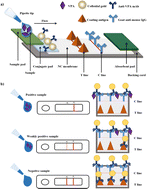A paper sensor for unbound valproic acid detection in human serum†
Abstract
Valproic acid (VPA) is mainly used in the clinic to treat epilepsy, for which the therapeutic window is narrow to avoid causing adverse reactions such as hepatotoxicity and teratogenicity. Therefore, timely therapeutic drug monitoring is needed. A hapten containing a benzene ring and an amino group was designed and used to screen a monoclonal antibody (mAb) 3G10 with high specificity and sensitivity. The IC50 value of mAb 3G10 was ascertained as 68.13 ng mL−1 through an indirect competitive enzyme-linked immunosorbent assay. A colloidal gold-based immunochromatographic strip (CG-ICS) for the detection of free VPA in human serum was developed with gold-labeled mAb 3G10. Qualitative analysis of human serum samples can be conducted through visual observation. The visual limit of detection (vLOD) was 2 μg mL−1, and the cut-off value was 100 μg mL−1. A standard curve for quantitative detection was generated using a portable scanner, with a calculated LOD (cLOD) value of 0.144 μg mL−1 and a linear range of 0.565–48.385 μg mL−1. Comparing the results of CG-ICS for actual positive samples with those of a direct chemiluminescence kit, there was a good correlation between the two methods. Therefore, our CG-ICS can be applied to the rapid clinical monitoring of free VPA.



 Please wait while we load your content...
Please wait while we load your content...